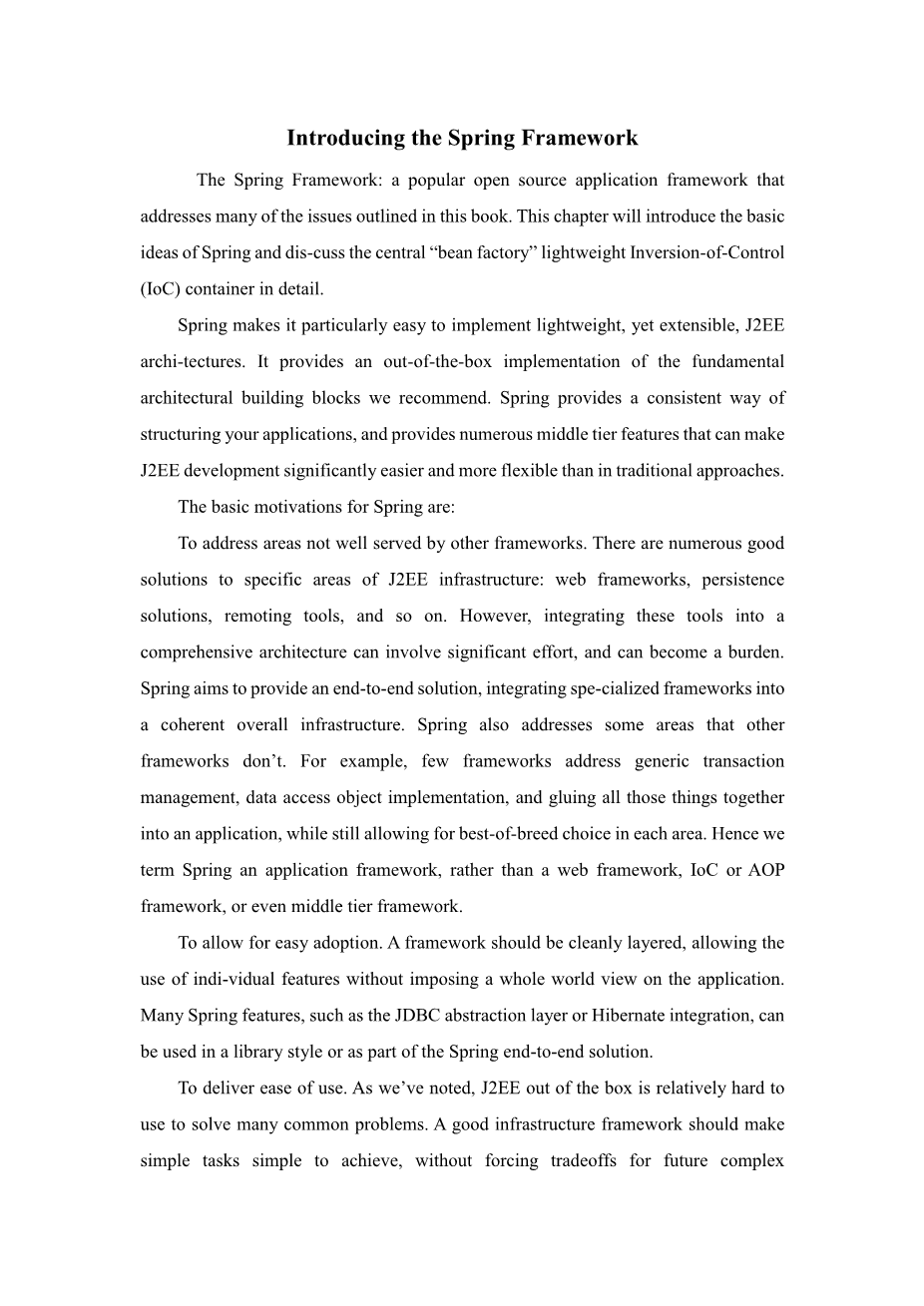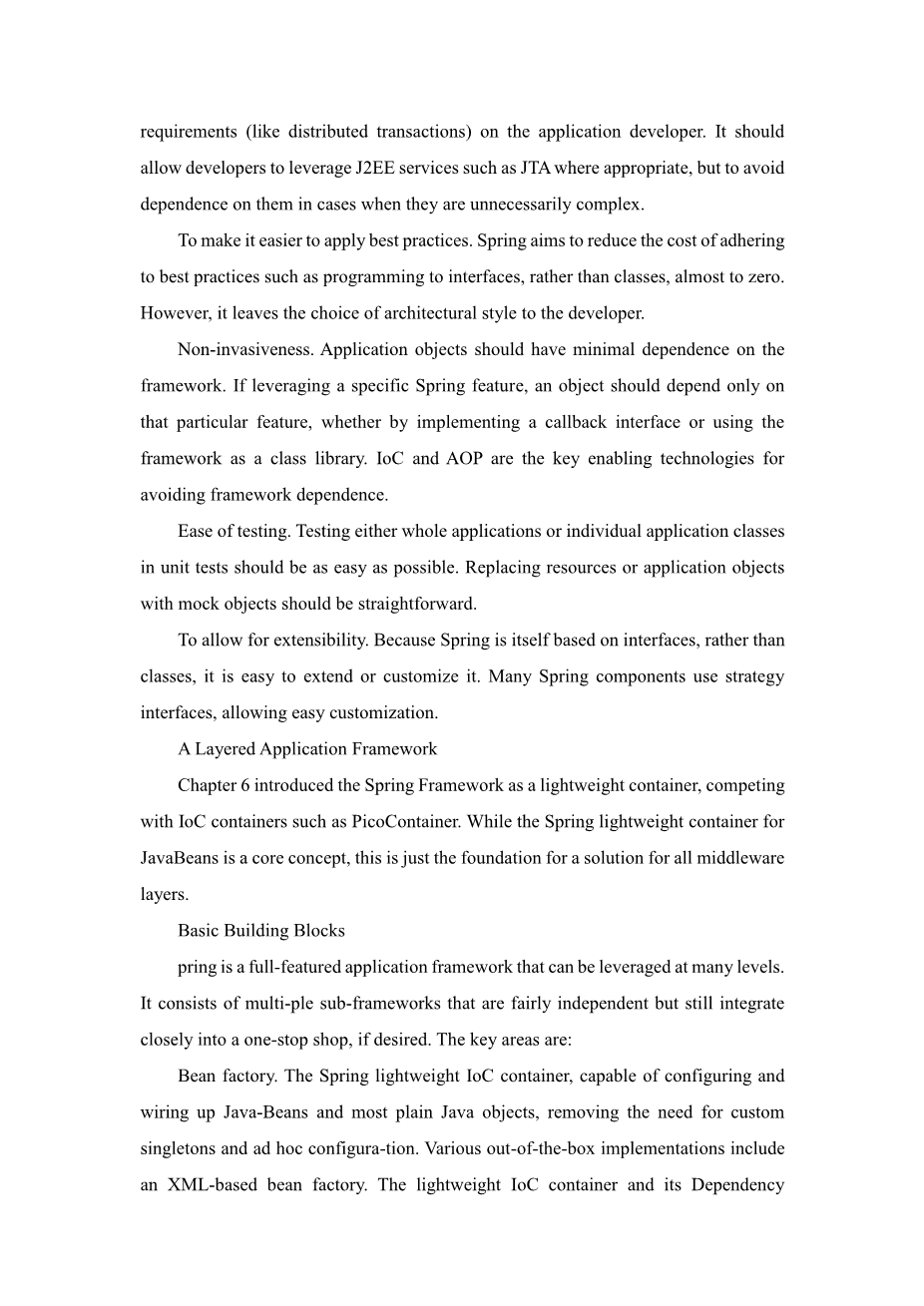

英语原文共 11 页,剩余内容已隐藏,支付完成后下载完整资料
Introducing the Spring Framework
The Spring Framework: a popular open source application framework that addresses many of the issues outlined in this book. This chapter will introduce the basic ideas of Spring and dis-cuss the central “bean factory” lightweight Inversion-of-Control (IoC) container in detail.
Spring makes it particularly easy to implement lightweight, yet extensible, J2EE archi-tectures. It provides an out-of-the-box implementation of the fundamental architectural building blocks we recommend. Spring provides a consistent way of structuring your applications, and provides numerous middle tier features that can make J2EE development significantly easier and more flexible than in traditional approaches.
The basic motivations for Spring are:
To address areas not well served by other frameworks. There are numerous good solutions to specific areas of J2EE infrastructure: web frameworks, persistence solutions, remoting tools, and so on. However, integrating these tools into a comprehensive architecture can involve significant effort, and can become a burden. Spring aims to provide an end-to-end solution, integrating spe-cialized frameworks into a coherent overall infrastructure. Spring also addresses some areas that other frameworks donrsquo;t. For example, few frameworks address generic transaction management, data access object implementation, and gluing all those things together into an application, while still allowing for best-of-breed choice in each area. Hence we term Spring an application framework, rather than a web framework, IoC or AOP framework, or even middle tier framework.
To allow for easy adoption. A framework should be cleanly layered, allowing the use of indi-vidual features without imposing a whole world view on the application. Many Spring features, such as the JDBC abstraction layer or Hibernate integration, can be used in a library style or as part of the Spring end-to-end solution.
To deliver ease of use. As wersquo;ve noted, J2EE out of the box is relatively hard to use to solve many common problems. A good infrastructure framework should make simple tasks simple to achieve, without forcing tradeoffs for future complex requirements (like distributed transactions) on the application developer. It should allow developers to leverage J2EE services such as JTA where appropriate, but to avoid dependence on them in cases when they are unnecessarily complex.
To make it easier to apply best practices. Spring aims to reduce the cost of adhering to best practices such as programming to interfaces, rather than classes, almost to zero. However, it leaves the choice of architectural style to the developer.
Non-invasiveness. Application objects should have minimal dependence on the framework. If leveraging a specific Spring feature, an object should depend only on that particular feature, whether by implementing a callback interface or using the framework as a class library. IoC and AOP are the key enabling technologies for avoiding framework dependence.
Ease of testing. Testing either whole applications or individual application classes in unit tests should be as easy as possible. Replacing resources or application objects with mock objects should be straightforward.
To allow for extensibility. Because Spring is itself based on interfaces, rather than classes, it is easy to extend or customize it. Many Spring components use strategy interfaces, allowing easy customization.
A Layered Application Framework
Chapter 6 introduced the Spring Framework as a lightweight container, competing with IoC containers such as PicoContainer. While the Spring lightweight container for JavaBeans is a core concept, this is just the foundation for a solution for all middleware layers.
Basic Building Blocks
pring is a full-featured application framework that can be leveraged at many levels. It consists of multi-ple sub-frameworks that are fairly independent but still integrate closely into a one-stop shop, if desired. The key areas are:
Bean factory. The Spring lightweight IoC container, capable of configuring and wiring up Java-Beans and most plain Java objects, removing the need for custom singletons and ad hoc configura-tion. Various out-of-the-box implementations include an XML-based bean factory. The lightweight IoC container and its Dependency Injection capabilities will be the main focus of this chapter.
Application context. A Spring application context extends the bean factory concept by adding support for message sources and resource loading, and providing hooks into existing environ-ments. Various out-of-the-box implementations include standalone application contexts and an XML-based web application context.
AOP framework. The Spring AOP framework provides AOP support for method interception on any class managed by a Spring lightweight container. It supports easy proxying of beans in a bean factory, seamlessly weaving in interceptors and other advice at runtime. Chapter 8 dis-cusses the Spring AOP framework in detail. The main use of the Spring AOP framework is to provide declarative enterprise services for POJOs.
Auto-proxying. Spring provides a higher level of abstraction over the AOP framework and low-level services, which offers similar ease-of-use to .NET within a J2EE context. In particular, the provision of declarative enterprise services can be driven by source-level metadata.
Transaction management. Spring provides a generic transaction management infrastructure, with pluggable
剩余内容已隐藏,支付完成后下载完整资料
资料编号:[441818],资料为PDF文档或Word文档,PDF文档可免费转换为Word


